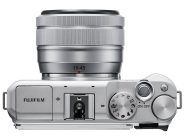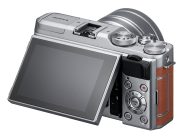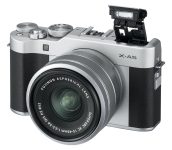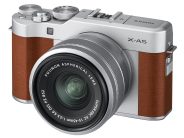Announced
Production status
System
Fujifilm X system cameras
- Fujifilm X-A1
- Fujifilm X-A10
- Fujifilm X-A2
- Fujifilm X-A20
- Fujifilm X-A3
- Fujifilm X-A5
- Fujifilm X-A7
- Fujifilm X-E1
- Fujifilm X-E2
- Fujifilm X-E2S
- Fujifilm X-E3
- Fujifilm X-E4
- Fujifilm X-H1
- Fujifilm X-H2
- Fujifilm X-H2S
- Fujifilm X-M1
- Fujifilm X-Pro1
- Fujifilm X-Pro2
- Fujifilm X-Pro2 Graphite Edition
- Fujifilm X-Pro3
- Fujifilm X-S10
- Fujifilm X-S20
- Fujifilm X-T1
- Fujifilm X-T1 Graphite Silver Edition
- Fujifilm X-T10
- Fujifilm X-T100
- Fujifilm X-T2
- Fujifilm X-T2 Graphite Silver Edition
- Fujifilm X-T20
- Fujifilm X-T200
- Fujifilm X-T3
- Fujifilm X-T30
- Fujifilm X-T30 II
- Fujifilm X-T4
- Fujifilm X-T5
- Fujifilm X-T50
Fujifilm X-A5
APS-C AF digital mirrorless camera • Discontinued
Specification
| Format: | |
| APS-C | |
Imaging sensor: | 23.5 × 15.7mm CMOS sensor |
Resolution: | 6000 × 4000 - 24 MP |
Crop factor: | 1.53x |
Sensor-shift image stabilization: | - |
| Fujifilm X [17.7mm] | |
| Shutter: | |
Type: | Focal-plane |
Model: | Electronically controlled |
Speeds: | 30 - 1/32000 + B |
| Exposure: | |
Exposure metering: | Through-the-lens (TTL), open-aperture |
Exposure modes: | Programmed Auto |
| Aperture-priority Auto | |
| Shutter-priority Auto | |
| Manual | |
| Physical characteristics: | |
Weight: | 361g |
Dimensions: | 116.9x67.7x40.4mm |
Manufacturer description
Valhalla, N.Y., January 31, 2018 – FUJIFILM North America Corporation is excited to announce the new FUJIFILM X-A5 Digital Camera Body with XC15-45mm Lens Kit, the lightest camera-zoom lens combination within the X Series lineup. With a host of new and improved features, the X-A5 kit debuts the new FUJINON XC15-45mmF3.5-5.6 OIS PZ, the first electric powered zoom lens for X Mount digital cameras. Available in three colors of synthetic leather, the X-A5 is equipped with the latest Bluetooth® technology for quick and easy image transfer and allows for a broader range of video capabilities with its 4K output.
“The X-A5 packs Fujifilm’s renowned image quality and exciting fun features in a compact, lightweight body,” says Yuji Igarashi, General Manager of the Electronic Imaging Division & Optical Devices Division at FUJIFILM North America Corporation. “We are excited to bring a user-friendly camera that can capture great images, to the market at an affordable price.”
Featuring an Enhanced Sensor and Color Reproduction Technology
The X-A5 features a powerful 24.2MP APS-C sensor equipped with phase detection autofocus and a newly developed image processing engine with a processing speed 1.5 times faster than that of previous models. Combined with Fujifilm’s renowned color reproduction technology, the X-A5 achieves outstanding image quality and outperforms previous models in its scene recognition accuracy and skin tone reproduction, making it perfect for portraits.
The X-A5 is the first in the X-A series to feature phase detection pixels, and an intelligent Hybrid AF system that focuses twice as fast as previous models to ensure capture of swiftly moving subjects. With an ISO sensitivity range now up to ISO12800 and extended sensitivity range up to ISO51200, camera shake and noise are significantly reduced even in low-light conditions.
New Compact and Lightweight Electric Powered Zoom Lens
The new X-A5 introduces the first electric powered zoom lens for X Mount cameras, the FUJINON XC15-45mmF3.5-5.6 OIS PZ. With a minimum working distance of just 2 inches, this lightweight and compact lens is great for achieving clear close-up shots while making the photographic experience easy and comfortable. Capable of capturing crisp, intricate textures, the XC15-45mmF3.5-5.6 OIS PZ is ideal for food and macro photography. Starting at a wide angle, this smooth electric-powered zoom also allows for great freedom in composition framing.
The new XC15-45mmF3.5-5.6 OIS PZ lens will also be available for standalone purchase as a portable addition for existing X Series users.
Equipped with 4K Video Capabilities
The X-A5 features a variety of 4K video capabilities. Utilizing the Burst Function, users are able to shoot 15 frames per second in 4K image quality, ensuring that photo opportunities are never missed. Offering an HD video function to record videos up to quad speed for slow motion clips and a Multi Focus Mode which stacks 4K quality images and automatically changes the depth of field setting, the X-A5 is the perfect companion for a wide range of creative captures.
Bluetooth® Pairing Technology for Easy Image Transfer
Featuring the latest Bluetooth® technology, the X-A5 allows for automatic transfer of images and videos to paired smart devices using the free “FUJIFILM Camera Remote” app. The camera is compatible with Instax Share™ Printers to instantly transfer and print images directly from the camera.
Film Simulation Modes and Improved User Interface for Ease of Operation
The X-A5 allows for artistic expression through Fujifilm’s unique Film Simulation Modes that boast the company’s advances in color reproduction. Offering eleven different modes, users can add a creative twist to their images. In addition, the camera offers seventeen variations of Advanced Filters including the new “Fog Remove” and “HDR Art.”
An improved user interface allows for superior ease of use. The large LCD screen uses new touch-panel GUI, facilitating intuitive operation and is capable of rotating 180 degrees, making the X-A5 perfect for taking high quality self-portraits. When the panel is rotated 180 degrees, the Rear Command Dial switches to the Zoom and Shutter Release function and automatically activates the Eye AF function for sharp focus on the subject’s eyes. Additionally, the Portrait Enhancer Mode allows for users to select from three levels of skin tone enhancement with easy touchscreen operation.
FUJIFILM X-A5 Key Features:
- 24.2MP APS-C CMOS sensor and newly developed processor equipped with phase detection AF system
- FUJINON XC15-45mmF3.5- 5.6 OIS PZ wide angle electric-powered zoom lens with minimum working distance of 2”
- 3” (approx. 1,040K-dot) high resolution LCD touchscreen using new touch-panel GUI can be tilted to 180°
- Portrait Enhancement Level, Touch AF in Movie Mode, Advanced Filter Select
- Standard output sensitivity of ISO200 – ISO12800
- Extended output sensitivity: ISO100 – ISO51200
- 4K video recording up to approx. 5 mins
- Full HD 1920 x 1080 59.94p / 50p / 24p / 23.98p; continuous recording up to approx.14 mins
- HD 1280 x 720 59.94p / 50p / 24p / 23.98p; continuous recording up to approx. 27 mins
- High Speed Movie 1280x720 1.6x / 2x / 3.3x / 4x
- Bluetooth® version 4.1 low energy technology
- In-camera RAW processing
- New Advanced Filters: “Fog Remove” and “HDR Art”
- Wi-Fi® image transfer and remote camera operation
- Improved battery life for still images - approx. 450 frames
- Improved start-up period:
- 0.4 sec., when High Performance mode set to ON
- 0.8 sec., when High Performance mode set to OFF
- Photos can be sent to instax SHARE printers using the free instax SHARE App (iOS and Android)
- Accessories include: Li-ion battery NP-W126S, AC power adapter, Plug adapter, USB cable, Shoulder strap, Body cap, Owner's manual






